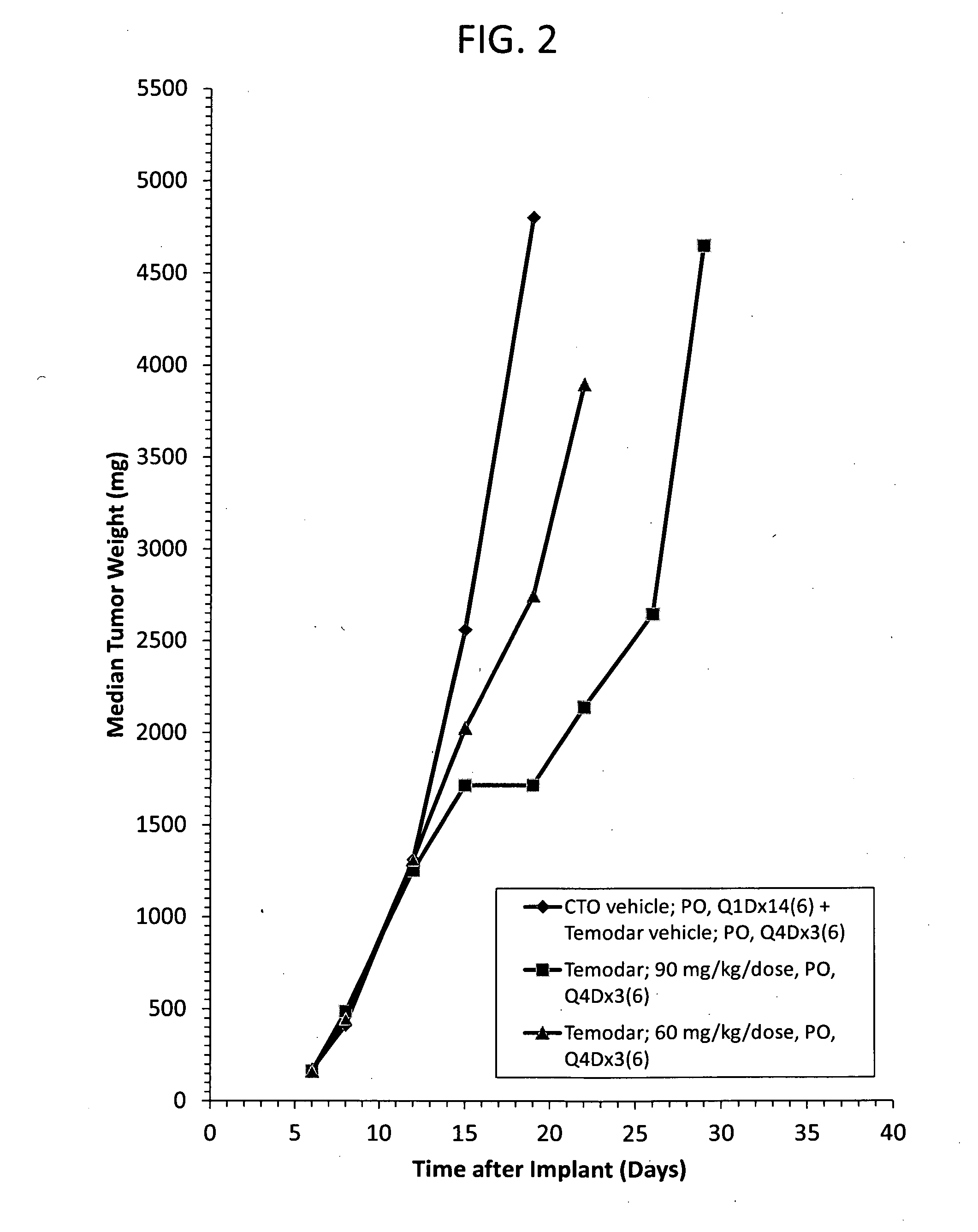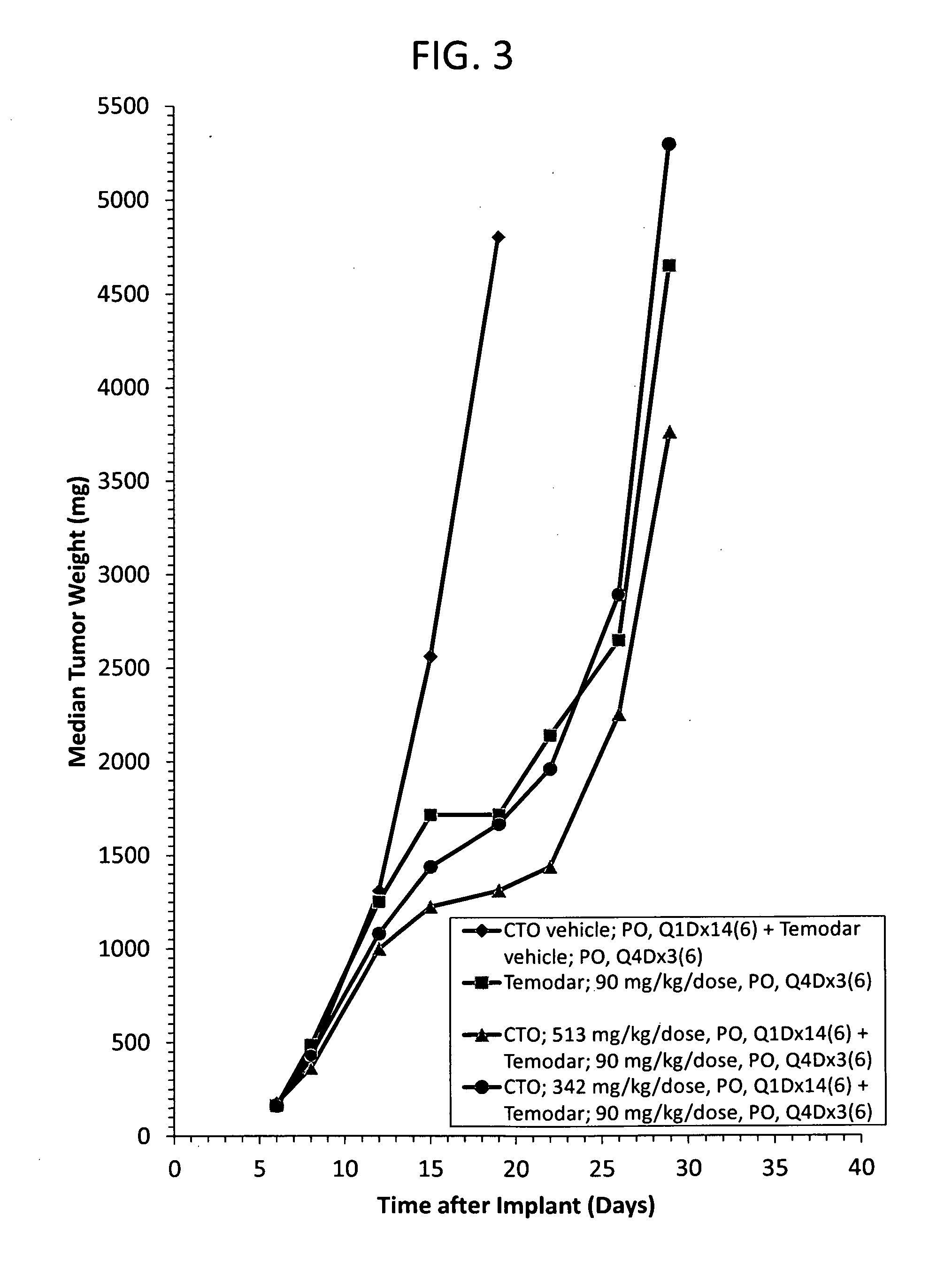Methods and compositions for enhancing sensitivity of cytotoxic drugs with timely combinatorial therapy with carboxyamidotriazole orotate
a technology of carboxyamidotriazole and cytotoxic drugs, which is applied in the direction of drug compositions, biocide, heterocyclic compound active ingredients, etc., can solve the problems of increased dose, severe toxicities in cancer patients, loss of effective cure capacity of tumors, etc., to maintain the sensitivity and efficacy of biologics, prevent and/or reduce drug resistance, and enhance the sensitivity of cytotoxic drugs
- Summary
- Abstract
- Description
- Claims
- Application Information
AI Technical Summary
Benefits of technology
Problems solved by technology
Method used
Image
Examples
example 1
Titration of Combinatorial Therapeutics in Normal Mice
[0048]The purpose of the first experiment was to evaluate the tolerance of female athymic NCr-nu / nu mice to the combination treatment of 5-amino-1-(4-(4-chlorobenzoyl)-3,5-dichlorobenzyl)-1,2,3-triazole-4-carboxyamide orotate (CTO) and a cytotoxic chemotherapeutic agent selected from the group consisting of temozolomide, 5-FU, methotrexate, doxorubicin and daunorubicin.
[0049]Polyethylene glycol (PEG 400, MW 400) was purchased from Aldrich Chemistry. Deionized water was purchased from LabChem, Inc. Klucel (hydroxypropyl cellulose) was purchased from Aldrich. Saline (physiological saline solution, for animal use only) was purchased from Nova-Teck, Inc. Tween 80 (T80, polysorbate 80) was purchased from Fisher Scientific. CTO (MW 580.76) was stored at room temperature protected from light upon receipt. CTO was formulated once a week (on Days 1 and 8) at a concentration of 51.3 mg / mL in 40% PEG 400 in deionized water. Temozolomide® (t...
example 2
Cominatorial Therapy with Temozolomide and CTO in Xenograft Model of Human LOX IMVI Melanoma in Mice
[0052]The purpose of the experiment TTI-6A was to evaluate the antitumor activity of CTO when administered in combination with temozolomide against subcutaneously (SC)-implanted human LOX IMVI melanoma xenografts in female, athymic NCr-nu / nu mice. Female six-week-old athymic NCr-nu / nu mice were purchased from Charles River Laboratories (Wilmington, Mass.). Human LOX IMVI melanoma cells were maintained as an ascites passage. Each mouse was implanted SC near the right flank with one million (1×106) of the LOX IMVI human melanoma cell from an in vivo passage using a 23 g needle. The day of tumor fragment implantation was designated as Day 0. Individual tumors of 90 animals grew to 126-198 mg in weight (126-198 mm3 in size) on Day 6 after tumor implantation (Jul. 20, 2011), the day of treatment initiation. Those animals selected with tumors in the proper size range were assigned to nine t...
PUM
| Property | Measurement | Unit |
|---|---|---|
| concentration | aaaaa | aaaaa |
| concentration | aaaaa | aaaaa |
| weight | aaaaa | aaaaa |
Abstract
Description
Claims
Application Information
 Login to View More
Login to View More - R&D
- Intellectual Property
- Life Sciences
- Materials
- Tech Scout
- Unparalleled Data Quality
- Higher Quality Content
- 60% Fewer Hallucinations
Browse by: Latest US Patents, China's latest patents, Technical Efficacy Thesaurus, Application Domain, Technology Topic, Popular Technical Reports.
© 2025 PatSnap. All rights reserved.Legal|Privacy policy|Modern Slavery Act Transparency Statement|Sitemap|About US| Contact US: help@patsnap.com



